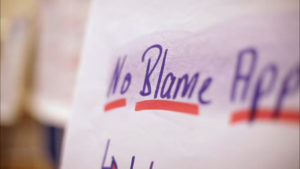The No Blame Approach (NBA) has been developed in the beginning of the 1990-ties in England by George Robinson, long term headmaster of a school for children with behavioral disorders and Barbara Maines, school psychologist. They were looking for a constructive method to fight bullying in the case of a teenage boy whose teacher had asked them for help as Maines and Robinson describe in their publication: Crying for help – the No Blame Approach to Bullying: “We wanted a strategy that was safe, did not accuse, interrogate or alienate young people. We wanted a process that would improve relationships between young people and the adults working with them.” 1

Up to then different bullying intervention tools have been applied which foresaw severe consequences for the bullying student. However, punishment and negative consequences did not necessarily improve the situation for the bullied child but also carried the danger of revenge. So Barbara Maines and George Robinson designed a concept which did not focus on punishment but rather on the belief that, if group dynamics in a classroom changed – meaning that the bullying actions would no longer be considered cool or funny by the other classmates – the bully will change his behavior and stop bullying.
And the results of the NBA intervention proved that it worked. In most cases the bullying was stopped.
By now the No Blame Approach is used in the following countries: New Zealand, Switzerland, the Netherlands, Belgium and Germany.